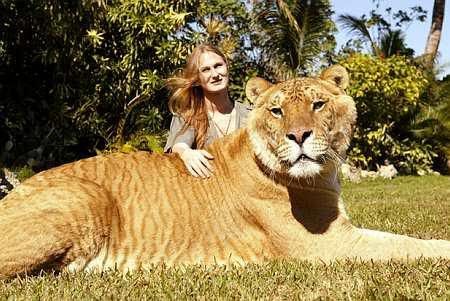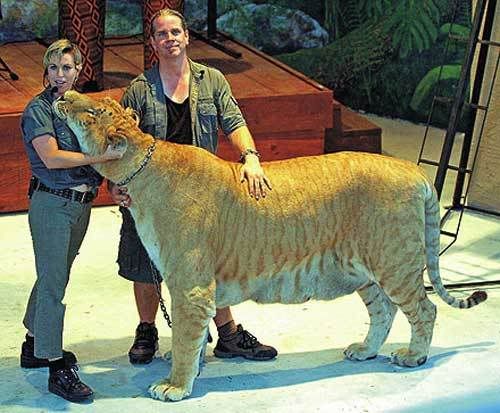 The liger is a hybrid cross between a male Panthera leo (lion), and a female Panthera tigris (Tiger) and is denoted scientifically as Panthera tigris × Panthera leo. A liger resembles a giant lion with diffused stripes. They are the largest cats in the world, although the Siberian Tiger is the largest pure sub-species. Like tigers, but unlike lions, ligers enjoy swimming. A similar hybrid, the offspring of a male tiger and a female lion is called a tigon.
The liger is a hybrid cross between a male Panthera leo (lion), and a female Panthera tigris (Tiger) and is denoted scientifically as Panthera tigris × Panthera leo. A liger resembles a giant lion with diffused stripes. They are the largest cats in the world, although the Siberian Tiger is the largest pure sub-species. Like tigers, but unlike lions, ligers enjoy swimming. A similar hybrid, the offspring of a male tiger and a female lion is called a tigon.According to The Tiger, Symbol of Freedom rare reports have been made of tigresses mating with lions in the wild. Under exceptional circumstances it has been known for a tiger to be forced into ranges inhabited by the Asiatic Lion, Panthera leo persica, which is a different species as the tiger, Panthera tigris. This may have occurred in the Gir Forest in India where the ranges of Asiatic Lions and Bengal Tigers overlap. This combination of species in the wild however is considered improbable.
Ligers grow much larger than lions and even larger than the largest tigers. On average, ligers stand at about 10-12 ft when standing on their hind legs. The largest non-obese Liger, known as Hercules, is said to weigh over 544kg (1200 lb), over twice the size of a male lion. Hercules was also featured in Maxim magazine article in 2005, when he was only 3 years old and already weighed 408 kg (900 lb) at the time. The liger is the largest animal in the cat family (feline family Felidae)
Imprinted genes may be a factor contributing to liger size.[10] These are genes that may or may not be expressed depending on the parent they are inherited from, and that occasionally play a role in issues of hybrid growth. For example, in some mice species crosses, genes that are expressed only when maternally-inherited cause the young to grow larger than is typical for either parent species. This growth is not seen in the paternal species, as such genes are normally "counteracted" by genes inherited from the female of the appropriate species.
 Another possible hypothesis is that the growth dysplasia results from the interaction between lion genes and tiger womb environment. The tiger produces a hormone that sets the fetal liger on a pattern of growth that does not end throughout its life. The hormonal hypothesis is that the cause of the male liger's growth is its sterility — essentially, the male liger remains in the pre-pubertal growth phase. This is not upheld by behavioural evidence - despite being sterile, many male ligers become sexually mature and mate with females. Male ligers also have the same levels of testosterone ng/dl on average as an adult male lion. In addition, female ligers also attain great size, weighing approximately 700 lb (320 kg) and reaching 10 feet (3.05 m) long on average, but are often fertile.
Another possible hypothesis is that the growth dysplasia results from the interaction between lion genes and tiger womb environment. The tiger produces a hormone that sets the fetal liger on a pattern of growth that does not end throughout its life. The hormonal hypothesis is that the cause of the male liger's growth is its sterility — essentially, the male liger remains in the pre-pubertal growth phase. This is not upheld by behavioural evidence - despite being sterile, many male ligers become sexually mature and mate with females. Male ligers also have the same levels of testosterone ng/dl on average as an adult male lion. In addition, female ligers also attain great size, weighing approximately 700 lb (320 kg) and reaching 10 feet (3.05 m) long on average, but are often fertile.While male ligers are sterile, female ligers are fertile, and they can reproduce. If a liger were to reproduce with a tiger, it would be called a ti-liger, and if it were to reproduce with a lion, it would be called a li-liger. The fertility of hybrid big cat females is well-documented across a number of different hybrids. This is in accordance with Haldane's rule: in hybrids of animals whose gender is determined by sex chromosomes, if one gender is absent, rare or sterile, it is the heterogametic sex (the one with two different sex chromosomes e.g. X and Y).
According to Wild Cats of the World (1975) by C. A. W. Guggisberg, ligers and tigons were long thought to be sterile: In 1943, however, a fifteen year old hybrid between a lion and an 'Island' tiger was successfully mated with a lion at the Munich Hellabrunn Zoo. The female cub, even though very delicate, was raised to adulthood.
Ligers have a tiger-like striping pattern on a lion-like tawny background. In addition they may inherit rosettes from the lion parent (lion cubs are rosetted and some adults retain faint markings). These markings may be black, dark brown or sandy. The background color may be correspondingly tawny, sandy or golden. In common with tigers, their underparts are pale. The actual pattern and color depends on which subspecies the parents were and on the way in which the genes interact in the offspring.
 White tigers have been crossed with lions to produce "white" (actually pale golden) ligers. In theory white tigers could be crossed with white lions to produce white, very pale or even stripeless ligers. A black liger would require both a melanistic tiger and a melanistic lion as parents. Very few melanistic tigers have ever been recorded, most being due to excessive markings (pseudo-melanism or abundism) rather than true melanism. No reports of black lions have ever been substantiated. A hypothetical procedure to breed black ligers is explained here. The blue or Maltese Tiger is now unlikely to exist, making grey or blue ligers an impossibility. It is not impossible for a liger to be white, but it is very rare.
White tigers have been crossed with lions to produce "white" (actually pale golden) ligers. In theory white tigers could be crossed with white lions to produce white, very pale or even stripeless ligers. A black liger would require both a melanistic tiger and a melanistic lion as parents. Very few melanistic tigers have ever been recorded, most being due to excessive markings (pseudo-melanism or abundism) rather than true melanism. No reports of black lions have ever been substantiated. A hypothetical procedure to breed black ligers is explained here. The blue or Maltese Tiger is now unlikely to exist, making grey or blue ligers an impossibility. It is not impossible for a liger to be white, but it is very rare.- wikipedia goblog -

6 comments:
Keep breeding ligers they look good well cared and healthy too i hope to see one in person and get a chance to touch one too. My name luis i am from delaware currently in A I HIGH SCHOOL
I think it is awesome that you are breeding these ligers, because they are so big and they are amazing to see in real life. When I hear liger I think of Napolean Dynamite, because he draws them and says that they are his favorite animal. Maybe sometime you could put these ligers in zoos, because I know that people would want to see them instead of just plain old tiger and a lion. Keep breeding them and consider the zoo thing, also take real good care of them.
Ligers are not naturaly in nature probably mainly due to their food need. Unlike hybrid dogs who are bred for specific purpose (hunting, speed, herding etc...) Ligers are bred only for the amusement of man. Offspring males are typically born sterile and the mortality rate for all of them are exceptionally high. Do not breed these on purpose.
I am a cat lover, I don`t care what kind. How ever I am very troubled by this. They are beautiful, but the are not God`s handy work. That troubles me. Also any thing rear is always abused by humans this is an even bigger concern. We human will take advantage of this and those animals can be very dangerous in the wrong hands. That said they are beautiful, keep taking good care of them.
The actions of humans have caused the extinction of so many beautiful creatures that we will NEVER get the chance to admire from anything but a museum or a book. I think that the obviously careful and well thought out inter-species breeding is exciting, provided they are cared for accordingly, and are able to live a healthy, fulfilling existance. Its the least we can do, and maybe in the future this kind of genetic work will enable those many extinct creatures to once again breathe and exist alongside humans, like "god" originally intended.
Researchers are worrying that the tiger the largest living cat in the wild could very well be extinct in as little as twelve years. The world should be trying to prevent this from happening but many people would rather take different breeds of cats that are in captivity and breed them? God did not make this breed so why are we? I have read numerous reports on ligers that have serious mental and physical problems due to cross breeding. Life spans are not long at all. Why does people think this is a good idea? It's unfair to the animals!
Post a Comment